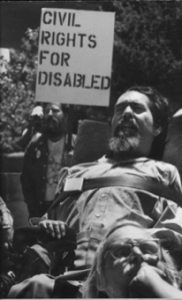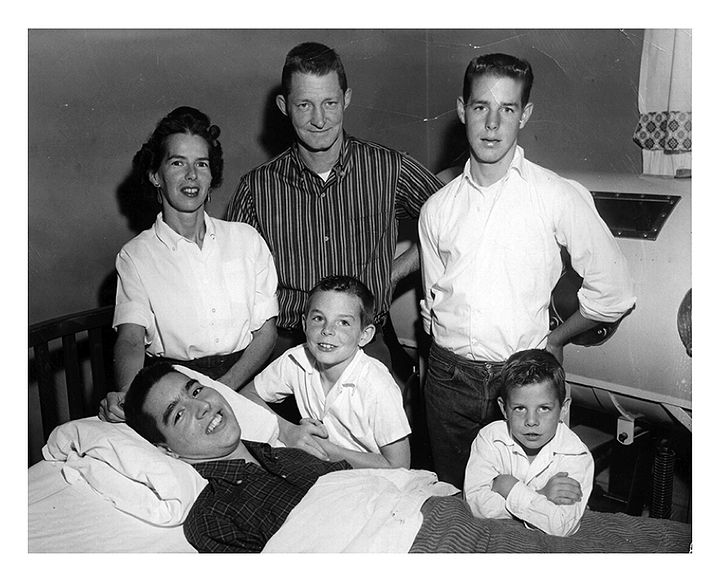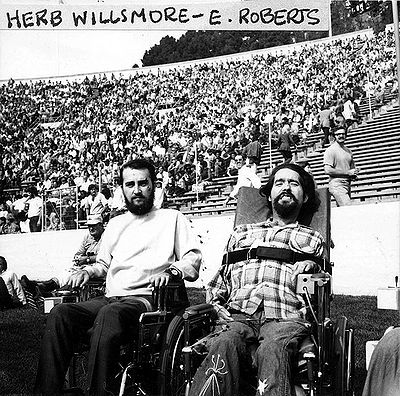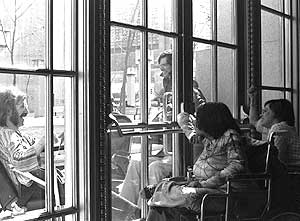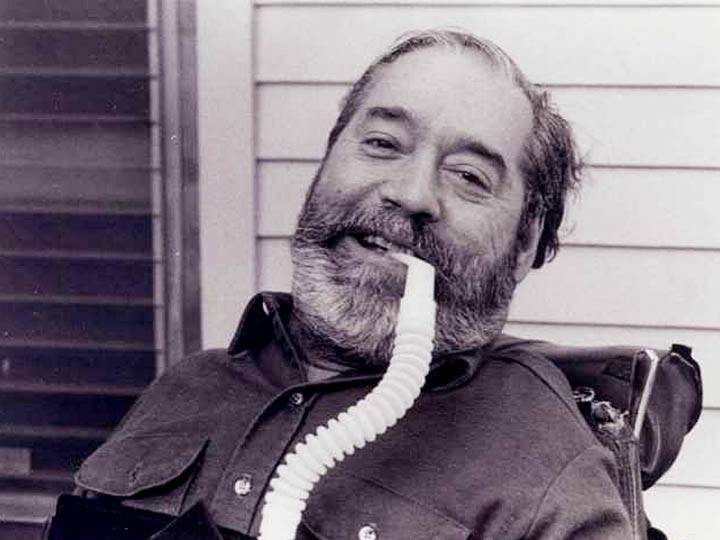Ed Roberts: The Father of Independent Living: Difference between revisions
(Addressing Injustice logo added) |
(linked to Bay Area Social Movements category) |
||
| Line 95: | Line 95: | ||
[[category:Famous characters]] [[category:Dissent]] [[category:1970s]] [[category:1980s]] [[category:1990s]] [[category:Civic Center]] | [[category:Famous characters]] [[category:Dissent]] [[category:1970s]] [[category:1980s]] [[category:1990s]] [[category:Civic Center]] [[category:Bay Area Social Movements]] | ||
Revision as of 14:56, 6 August 2014
Historical Essay
by Angela Anderson
Ed Roberts, described as the “father of independent living,” was the disability rights movement’s first major spokesperson. His mother Zona conceived him during her senior year of high school, briefly contemplating abortion. She would later joke that Ed graduated from Burlingame High School twice. Born in 1939, Ed grew into a tall young man and passionate athlete. When Ed was 14, Zona’s four boys fell ill, Ed most severely. While 90% of people affected by the poliomyelitis virus show no symptoms and act as carriers, about 5% will get mild flu symptoms. In 1% of those with polio, the virus leaves the intestinal tract and attacks the motor neurons of the spine. Ed, after being laid up with a headache, sat up in the car on the way to the hospital and walked in. The next day the polio diagnosis was confirmed by spinal tap, and the painful paralysis progressed quickly through Ed’s whole body. The year was 1953 - two years before Salk invented the polio vaccine.
Living in an iron lung, Ed stayed in the hospital for nine months and spent another nine in a polio center. Surrounded by nurses, Ed became depressed, at one point trying to refuse to eat. Zona sent the nurses away; with his decision-making returned to him, Ed’s depression eased. At 16, Ed returned home with an iron lung, which he referred to as his “tank.” The Easter Seals funded his home care (Palames).
Young Ed Roberts in bed at home.
A local women’s club, the Soroptomists (O’Hara), provided a telephone with a microphone and speakers for Ed to continue his schooling. Later Zona recognized in Ed the potential to attend school part-time. Despite Ed’s fear of people staring at him, Zona would not be swayed. Upon experiencing the staring while being lifted out of the car at school, Ed realized staring didn’t hurt, and instead decided to think of himself as a star (Palames).
Ed developed his gift for academics, and by the age of 20 he had completed all his academic high school credits. However, the Burlingame High School administration resisted allowing him to graduate, citing physical education and driver’s education requirements. Even after Zona’s suggestion that Ed’s physical therapy go towards his physical education requirements, one administrator was so bold as to visit Ed’s home and tell him to stay another year in high school so he didn’t get a “cheap” diploma; immediately, Zona escorted the administrator out of the house. She then went to a friend on the school board, which exempted him from the credits and arranged for Ed to graduate in 1959. The fight for the diploma was Ed’s first of many, but it taught him that pursuing what he wanted and deserved would always be a fight (O’Hara).
Ed got an associate’s degree from the College of San Mateo, where his focus shifted from sports writing to political science and public policy. Zona would take him to classes and write the papers he dictated. In the time before ventilators, whenever Ed was out of the iron lung, including in class, he practiced “frog breathing,” or swallowing air. One of his instructors, Jean Wirth, became a friend of his family, and encouraged Ed to abandon the notion of attending wheelchair-friendly UCLA in favor of the political science haven of UC Berkeley.
Zona, Ed, Jean and San Mateo Dean of Students Philip Morse made a trip to meet Berkeley’s Dean of Students, Arleigh Williams, who encouraged Ed to attend and gave them a list of housing options. However, as Zona noted, none of the dorms could fit an iron lung, so it was suggested they try the campus hospital, Cowell. Ed made sure that living in a hospital would be like living in a dorm, with his own attendants and orderlies filling in gaps in his care as needed. Ed had his own attendants from when he returned home from the polio center, who would drive him and push his wheelchair.
Initially the California Department of Rehabilitation refused to provide funding to Ed at Berkeley, declaring him “infeasible” for employment. At the time, Rehab practiced what Ed described as “creaming,” serving only clients with acute, curable conditions. The success of rehab counselors rested on the rate at which they closed out cases and how little money they spent. Very few clients fought for their rights after Rehab rejected them; many simply disappeared. However, after Rehab rejected Ed, Jean and Philip from the College of San Mateo went to the media, which pressured Rehab into providing Ed the maximum amount of aid at Berkeley.
Ed moved into Cowell; though scary to be living on his own and hiring his own attendants, Ed’s brother Ron was also attending Berkeley and provided support whenever it was needed. The next year a John Hessler, a second student with disabilities, moved in next door to Ed in Cowell. Early on, Ed worked for Arleigh as an accessibility consultant for the university, weighing in on proposed renovations and helping to move accessibility up the list of priorities at the school.
Early in his schooling, Ed contracted severe pneumonia. He moved back in with his parents, but his condition worsened and it was decided to return him to the hospital. The illness seriously disturbed Ed, who was too afraid that he was going to die to be able to go to sleep. However, he realized he had to relax to allow himself to get better; calling it the most important lesson he learned at Cal, Ed observed, “...the more uptight you are about your own sickness, you create more tension in your body…you can actually kill yourself and your zest for life…” (O’Hara 14).
Upon recovering, Ed was active in campus life. He went to football games, and attended classes in even the most inaccessible buildings. Routinely pulled up stairs in his push chair to classes, Ed had a scare when his chair once failed and he almost tumbled down the stairs. From then on Ed chose classes based on accessibility, and if he needed to traverse stairs he made sure that four people carried him. Ed would engage pretty women to write notes on carbon paper for him, and read for classes using a mirror and a mouthstick. Exams were administered however was settled with the professors. Ed garnered much local media attention, and was featured in Parade magazine.
Over the next few years, several more students with disabilities moved into Cowell, and they all received the maximum support from Rehab. However, several students were rejected, including a man with communication difficulties from cerebral palsy. The services provided to the students admitted to Berkeley served as a standard for students with severe disabilities across the country. Despite Rehab receiving federal grants to fund services, the Cowell students were sent a dictatorial counselor with the intention to micromanage the students’ grades and behavior, looking for any reason to cut their funding. After she wrongly ejected two students from the program, the Cowell students banded together, again approaching the media. They demanded Rehab fire the counselor, who instead was transferred and shortly retired. Ed observed of Rehab, “I think they still are awful in many ways, thinking they know more about what you want and need than you do, which I think is dumb. Nobody knows more” (O’Hara 27).
Later in his academic career, Ed’s stories display greater freedom in Berkeley of the sixties. He tells of experimenting with drugs, such as experiencing Telegraph Avenue while on acid with passersby wishing him a good trip. Cowell students drank, smoked pot and had intimate encounters in their hospital-dorm. Ed tells a story of a night drinking at a bar past Ashby. As the bar restroom wasn’t accessible, Ed went outside to relieve himself and a cop nearby told him he was under arrest. Ed responded, “You get me, I’ve got to have an iron lung. I’ll die in jail. You’ve got to have an iron lung. You’ve arrested me; now what are you going to do with me?” (O’Hara). The embarrassed cop called his sergeant, who chastised the officer as their jail wasn’t accessible and wouldn’t take anyone in a wheelchair, iron lung or not. The officers merely informed the university, and told Ed not to do it again.
Cowell students increasing got power wheelchairs, and Ed was inspired by their heightened freedom. He had tried a power chair years before, using the two fingers that recovered from the initial paralysis, but the technology had not developed to an extent where Ed could pilot them effectively. However, as the technology improved his motivations changed, including falling in love and wanting to be alone with his girlfriend, free of attendants. The Motorette provided this freedom, despite buggy transistors that would cause the chair to buck and rocket at full speed on one side. Ed carried extra transistors, and learned to coach strangers through replacing them. Though his relationship didn’t work out, Ed enjoyed the freedom of a power chair for the rest of his life.
In later years, Ed served as a teaching assistant for introductory political science courses. The independence of the power chair increased the assertiveness of Ed and his fellow Cowell students, who had begun moving into apartments. The group briefly discussed a halfway house program, but recognized it as unnecessary, as all they needed was support, attendants and access (O’Hara).
They referred to themselves as the Rolling Quads (Palames), but their efforts were formally called the Physically Disabled Students program. At the time Ed was becoming a national figure, but planes still did not allow respirators:
“In ‘70 Ed earned unofficial honors as High Flying Transcontinental Frog Breathing Champion when he flew 3000 air miles from the Bay Area to Washington DC – with no mechanical respiratory support – to advise on the distribution of anti-poverty funds used to create the Physically Disabled Students Program.” (Palames)
The program soon served non-student residents of Berkeley and evolved into the Center for Independent Living (Leon). During the first years of the CIL, Ed was teaching at Nairobi College, but he returned to Berkeley to serve as the CIL’s second executive director (Palames). Under Ed’s leadership, the CIL provided attendant and interpreter referral, accessible housing options, mobility training, help getting and keeping disability benefits, peer counseling, public education and advocacy, and the highly visible organization soon made Berkeley the most accessible city in the country (Leon).
In 1975, Governor Jerry Brown appointed Ed the director of the California Department of Rehabilitation, the same organization that had deemed him unable to work several years prior. Ed used the position to advocate for people with disabilities of all severities, establishing an office of consumer affairs and publishing a clients’ rights handbook. He also engaged in the battle for the enforcement of Section 504 of the Rehabilitation Act of 1973 - described as the Civil Rights Act for people with disabilities, Section 504
“...proclaimed that no handicapped individual shall, solely by reason of his handicap, be excluded from the participation in, be denied the benefits of, or be subjected to discrimination under any program or activity receiving Federal financial assistance.” (Leon)
By 1977, Section 504 was still unregulated, and people with disabilities began to demonstrate. The Bay Area had a strong and visible movement in which protesters occupied the offices of Carter’s Secretary of Health, Education and Welfare in San Francisco’s Federal building for 28 days (Leon). The government staff, initially condescendingly offering cookies and milk, eventually denied the protesters access to care providers and equipment such as back-up ventilators, cut phone lines, and refused to allow food - the physical survival of the protesters was in question.
Federal officials tried to push out demonstrators who, on April 5, 1977, hunkered down at the U.S. Department of Health, Education and Welfare office in San Francisco. Outgoing phone calls were blocked and hot water was turned off. But local support was widespread. Businesses donated supplies, members of the Black Panther Party cooked food, and the mayor sent in portable showers and mattresses.
Photo: HolLynn D'Lil
However, the community supported the occupation: food donated by unions and civil rights groups prepared and brought in by Black Panthers, the Butterfly Brigade, an anti-gay violence street patrol, smuggled in walkie-talkies, and even some of the staff smuggled in food and warned the protesters of potential police raids. Protesters communicated by sign language at windows with outside supporters. They wholly rejected the initially proposed “separate but equal” regulation, which would have established segregated schools for children with disabilities. By the end of the occupation, protesters won the exact language they wanted, as well as an additional bill addressing education for children with disabilities. These actions paved the way for the Americans with Disabilities Act (ADA) of 1990 (Stevens).
Once demonstrators left the HEW offices, they were not allowed back in. Those outside and inside communicated through the windows. Photographer HolLynn D'Lil wrote a poem about the image:
Through the Glass
Those who wouldn't go outside
Those who couldn't go inside
Shattered the walls.
The regulations’ effects were immediate: medical, nursing and professional schools were required to accept individuals with disabilities, new busses must be accessible, and courthouses must have ramp access. Ed also started independent living centers all over California, and influenced 1978 amendments to the federal Rehabilitation Act that provided funding to independent living centers nationwide (Leon). In 1978, Ed also fell in love with an occupational therapist and married, and they had a son, Lee (Palames).
Upon a regime change in California, Ed left his post at Rehab. He won the MacArthur “genius” grant, and co-founded the World Institute on Disability with Judy Heumann and Joan Leon. The institute served as a research and policy center focusing on the perspectives of individuals with disabilities. They successfully nationalized California’s In-Home Supportive Services Program national by adding the home service option of Medicaid, and fought for the ADA in 1990.
Ed continued his work with the World Institute on Disability until his death of a heart attack in 1995, at the age of 56. The service at UC Berkeley was attended by hundreds of disability and community leaders. Shortly thereafter the community established the Ed Roberts Campus, a universally designed, transit-oriented space at Ashby BART Station in Berkeley (Leon). His chair, complete with a Porsche seat, was donated by friends to the Smithsonian, which inspired the museum to include the history of disability in its collections (Ed Roberts’s Wheelchair).
Palames describes Ed’s voice as “reedy, pitched in high mid-range, his words measured in a cadence punctuated by the whoosh of a portable respirator slung under his chair,” that he used later in his life. Ed left us with the “Declaration of Interdependence,” observing that reciprocity, responsibility, and relationships create and sustain community (Palames). While he described himself professionally as a diplomat, who understands politics but practices them as he gets older (O’Hara), in keeping with his character, Ed’s best description of himself remains, “The vegetables of the world are uniting and we’re not going away!...I decided to be an artichoke, prickly on the outside but with a big heart!” (Palames).
Ed Roberts
References
Ed Roberts's wheelchair, about 1978. (2013). Retrieved November 15, 2013, from http://www.smithsonianlegacies.si.edu/objectdescription.cfm?ID=127
Leon, J. Ed Roberts, his life and his legacy. Retrieved November 16, 2013, from http://wid.org/about-wid/booklet%20with%20speech.pdf
O’Hara, Susan P. (1994). Oral history interview with Edward. V. Roberts. Retrieved November 15, 2013, from http://www.sos.ca.gov/archives/oral-history/pdf/roberts.pdf
Palames, C. (2011). Ed Roberts: Godfather of independent living. Retrieved November 15, 2013, from http://atotw.org/edroberts.html
Stevens, M. (2012). We want rights, not charity. Retrieved November 17, 2013, from http://socialistworker.org/2012/03/26/we-want-rights-not-charity

